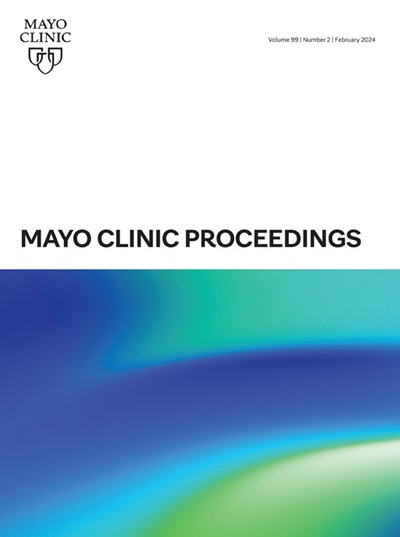绝经前妇女的代谢综合征和代谢功能障碍相关性脂肪肝:到 2040 年的全球趋势和预测》。
IF 6.9
2区 医学
Q1 MEDICINE, GENERAL & INTERNAL
引用次数: 0
摘要
目的:量化绝经前妇女代谢功能障碍相关性脂肪肝(MASLD)及相关代谢紊乱的负担:量化绝经前女性代谢功能障碍相关性脂肪性肝病(MASLD)及相关代谢紊乱的负担:2010年至2019年期间,对代谢性疾病(如MASLD、2型糖尿病、血脂异常、高血压、肥胖症和多囊卵巢综合征)的患病率、死亡率、残疾调整生命年(DALYs)及其年龄标准化率(ASR)进行了全球评估。根据地理区域和社会人口指数进行了分组评估。建立了预测模型,以估算到 2040 年的死亡率和残疾调整生命年:在 2019 年,高血压(11.37;9.52 至 13.45)和肥胖(10.49;7.57 至 13.64)的死亡反比率最高。相比之下,肥胖(816.13;581.41 至 1073.32)造成的残疾调整寿命年数增加最多,其次是高血压(634.73;536.75 至 744.77)。随着时间的推移,血脂异常(-0.55%)和高血压(-0.72%)的死亡率一直在下降,但肥胖(+0.58%)、2 型糖尿病(+0.85%)和乳腺癌(+0.51%)的死亡率却在上升。社会人口指数较低的国家显示出较高的残疾率与患病率比率。预计到 2040 年,肥胖将导致最多的死亡(比 2019 年增加 41.59%):代谢综合征的影响不断升级,与肥胖有关的死亡率呈上升趋势,绝经前妇女因地区和社会经济地位而存在的差异,都凸显出代谢综合征给全球带来的负担在惊人地增加。本文章由计算机程序翻译,如有差异,请以英文原文为准。
Metabolic Syndrome and Metabolic Dysfunction-Associated Steatotic Liver Disease in Premenopausal Women
Objective
To quantify the burden of metabolic dysfunction–associated steatotic liver disease (MASLD) and related metabolic disorders in premenopausal women.
Patients and Methods
Between 2010 and 2019, global evaluations of prevalence, mortality, disability-adjusted life years (DALYs), and their age-standardized rate (ASR) were conducted for metabolic conditions such as MASLD, type 2 diabetes mellitus, dyslipidemia, hypertension (HTN), obesity, and polycystic ovarian syndrome. Subgroup assessments were conducted according to geographical regions and the sociodemographic index. The predictive models were established to estimate mortality and DALYs through 2040.
Results
In 2019, the most significant ASR of deaths was found in HTN (11.37; 9.52 to 13.45), followed by obesity (10.49; 7.57 to 13.64). In contrast, the greatest ASR of DALYs was attributed to obesity (816.13; 581.41 to 1073.32), followed by HTN (634.73; 536.75 to 744.77). The mortality rates for dyslipidemia (–0.55%) and HTN (–0.72%) have been decreasing over time, but there has been an increase in obesity (+0.58%), type 2 diabetes mellitus (+0.85%), and MASLD (+0.51%). Lower sociodemographic index countries exhibit a higher disability-to-prevalence ratio. In 2040, obesity is predicted to cause the most deaths (+41.59% from 2019).
Conclusion
The escalating impact of metabolic syndrome, the rising trends in death rates linked to obesity, and the disparities based on region and socioeconomic status in premenopausal women underscore the alarming increase in the global burden of metabolic syndrome.
求助全文
通过发布文献求助,成功后即可免费获取论文全文。
去求助
来源期刊

Mayo Clinic proceedings
医学-医学:内科
CiteScore
16.80
自引率
1.10%
发文量
383
审稿时长
37 days
期刊介绍:
Mayo Clinic Proceedings is a premier peer-reviewed clinical journal in general medicine. Sponsored by Mayo Clinic, it is one of the most widely read and highly cited scientific publications for physicians. Since 1926, Mayo Clinic Proceedings has continuously published articles that focus on clinical medicine and support the professional and educational needs of its readers. The journal welcomes submissions from authors worldwide and includes Nobel-prize-winning research in its content. With an Impact Factor of 8.9, Mayo Clinic Proceedings is ranked #20 out of 167 journals in the Medicine, General and Internal category, placing it in the top 12% of these journals. It invites manuscripts on clinical and laboratory medicine, health care policy and economics, medical education and ethics, and related topics.
 求助内容:
求助内容: 应助结果提醒方式:
应助结果提醒方式:


